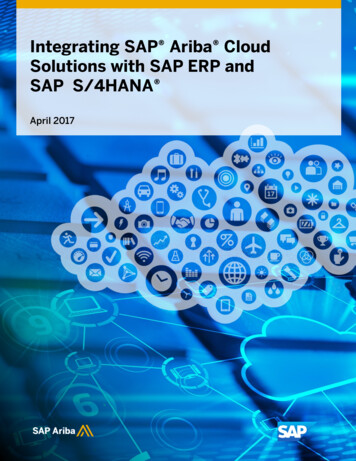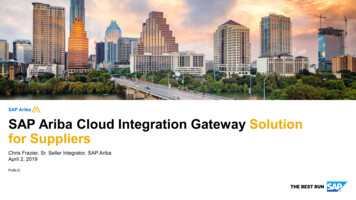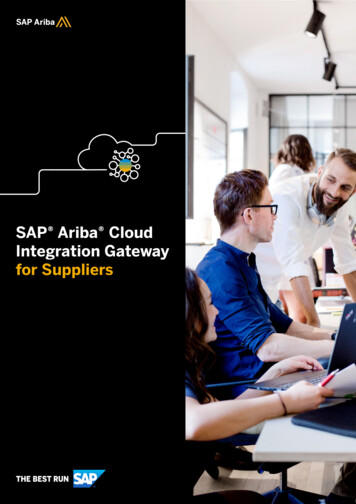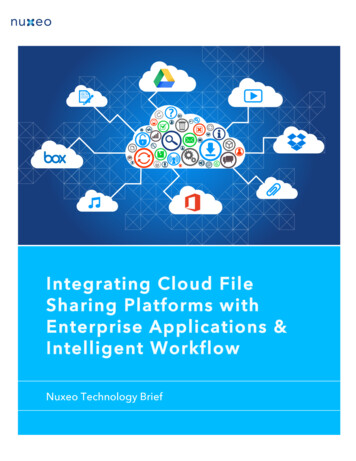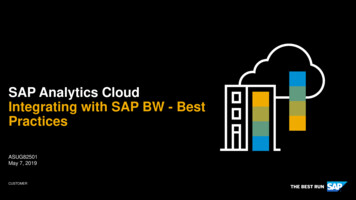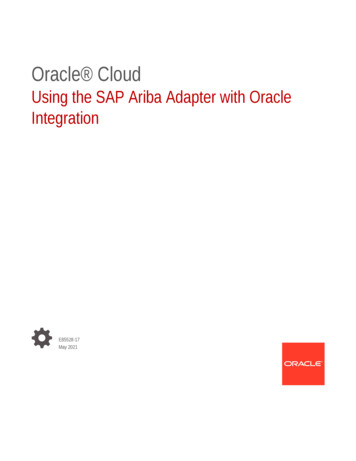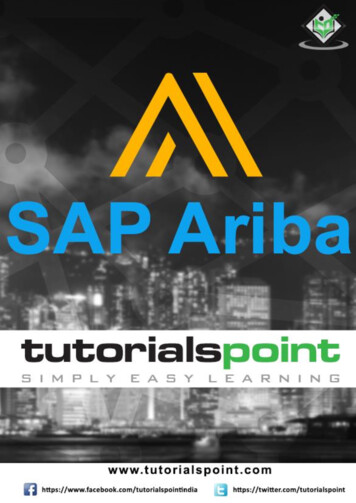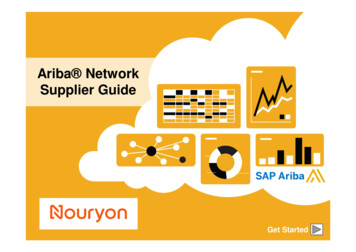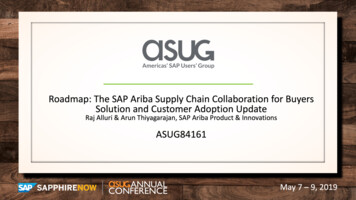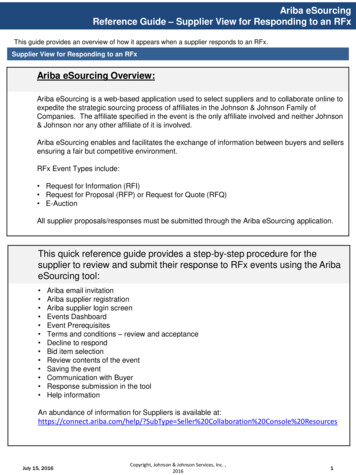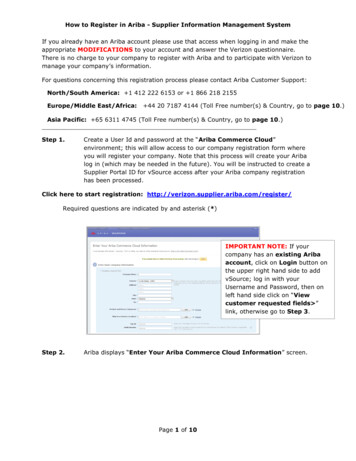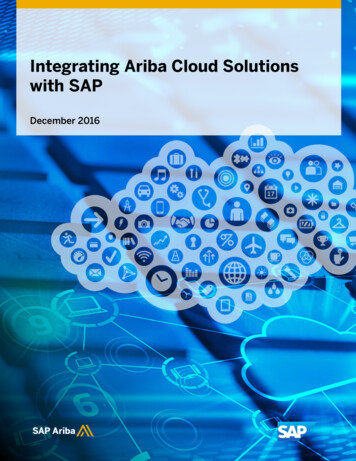
Transcription
Integrating Ariba Cloud Solutionswith SAPDecember 2016-1Integrating Ariba Cloud Solutions with SAP 2016 SAP SE. All rights reserved
CONTENTSIntroduction3The Customer Comes First3Ariba Cloud Solutions Integration with SAP ERP and S/4 HANA On-Premise4Ariba Network4Ariba Sourcing Solutions9Ariba Procurement and Invoicing Solutions11Ariba Cloud Integration Gateway, powered by SAP HANA Cloud Integration13The Future of SAP: S/4HANA and the Integrated Business Network14Upcoming Ariba Cloud Integration Enhancements14Appendix15-2Integrating Ariba Cloud Solutions with SAP 2016 SAP SE. All rights reserved
INTRODUCTIONfor all environments. However, that does not mean that therecannot be a consistent and simple approach to integration.SAP Ariba is the only cloud provider with true bi-directionalintegration into SAP ERP and SAP S/4 HANA including morethan 100 Integration processes and over 5000 fields integratedto the SAP Core.SAP Ariba’s approach to integration starts with the followingcustomer-centric integration goals: Protect and leverage customer’s SAP ERP and S/4 HANA OnPremise investments Minimize overall integration costs. Deliver a best-in-class, seamlessly integrated procurementbusiness process. Align with SAP’s strategy, assuring that today’s investmentswill continue to deliver value to customers for years to come.Integration with the Ariba solutions is achieved via the AribaCloud Integration framework. The Ariba Cloud Integrationframework is a suite of components and complementarytechnologies that can be optionally deployed depending on acustomer’s specific landscape. It can be installed as an Add-on to SAP ERP to directly connect to Ariba cloud solutions Adapter for SAP Process Integration (PI/PO)This document provides an executive-level summary of some ofthe most typical integration options between the procurementcapabilities provided by SAP ERP and the Ariba on-demandsolutions.To meet these customer-centric integration goals, SAP Aribadesigned a flexible and simple integration framework andintegration solutions based on: Choice – By designing the Ariba Cloud Integration frameworkto provide flexible integration options that fit into a customer’slandscape Open Standards – By using open standards and commontechnologies for connectivity and data exchange, allowingcustomers to leverage existing IT expertise Simplicity – By eliminating the need for new components,keeping the integration solution simple, and taking advantageof existing infrastructure and components Extensible Business Processes – By providing a rich portfolioof standard integrated business processes that customers canextend and adapt to meet their specific needsThe Customer Comes FirstSAP Ariba understands that customers have already madesignificant investments in IT and infrastructure, and that SAP ERPand S/4 HANA On-Premise landscapes in particular can be verycomplex for large enterprises. Many SAP ERP customers have along history of customizations and extensions that fine-tune thesolution to perfectly fit their specific need. Hence, no two SAPERP landscapes are exactly alike. As a result, there is no singleintegration solution that can be deployed in exactly the same wayAriba Strategic SourcingAriba P2PCatalog ContentAriba Cloud PlatformAriba NetworkSupplier CollaborationMaterials ManagementMaterial MasterPlant MaintenanceVendor MasterProject SystemBill of Materials Hierarchies5,000 Integrated FieldsPlanning DemandSRMCost Center AccountingAsset ManagementGeneral LedgerInventory ManagementMaster Data Governance (MDG)FinancialsSAP ECC and S/4 HANA On-PremiseProcureEnd to End Process Enablement-3Integrating Ariba Cloud Solutions with SAP 2016 SAP SE. All rights reservedContractFund Management
ARIBA CLOUD SOLUTIONS INTEGRATION WITH SAP ERP andS/4 HANA ON-PREMISE Intelligent - Ariba Network does not just transmit messages,but also validates their content to eliminate errors that delayprocessing and drive up cost.SAP ERP and S/4 HANA On-Premise customers integrate theirsystem with Ariba Network when they want to manage theirprocurement process within their SAP ERP or S/4 HANA OnPremise while also benefiting from the collaboration capabilitiesand efficiency gains that the Ariba Network can provide.SAP Ariba’s products are focused on two key areas: Ariba Network Ariba Applications - Ariba Procurement Solutions and AribaStrategic Sourcing SolutionsIn this paper we’ll explore the value proposition that each of theseproduct areas brings to you, and how they can be integratedseamlessly to provide added benefits for SAP ERP and S/4 HANAOn-Premise customers.Ariba Network integration with SAP ERP and S/4 HANA OnPremise is not limited to buying organizations. Suppliers on theAriba Network can have their SAP ERP systems integrated withthe Ariba Network as well.Ariba NetworkThe Ariba Network is a cloud-based network where buyers andsuppliers collaborate by managing different business processeseither via the Ariba Network portal or by exchanging commerceextensible markup language (cXML) messages. Buyingorganizations use the Ariba Network to find suppliers and to runautomated business transactions from ordering to issuingpayments. Suppliers use the Ariba Network to find new businessopportunities and to work more efficiently and effectively withtheir customers on all the shared aspects of business commerce:proposals, contracts, orders, invoices, and payments.Ariba Network and cXMLAriba, with the input of many other companies, has defined cXMLas an open protocol for business-to-business transactions in acommerce domain. This is the most comprehensive XMLstandard covering a wide variety of common business processesand the integration protocol that the Ariba Network is built upon.The cXML protocol is continuously updated to support newbusiness processes and new business documents. Seehttps://cXML.org for more information.The Ariba Network is Open – Ariba Network can integrate various kinds of buyersand suppliers using different technologies and protocols. Comprehensive – Ariba Network supports all businessprocesses and collaborations that are relevant for theprocurement of goods and services.BuyersSuppliersAdd-onMANAGECASHAdd-onSAP PIAriba NetworkAdapter for SAPNetWeaverAS2BUYSELLAriba NetworkDiscoverConnectCollaboratecXML-4 2016 SAP SE. All rights reservedEDIAriba CloudIntegration GatewayEDI Integration - X12/ EDIFACTBoomiConnectorIntegrating Ariba Cloud Solutions with SAPCSV
Ariba Network and SAP ERP and S/4 HANA OnPremiseSAP Ariba also provides native integration with SAP S/4 HANAOn-Premise for select business scenarios – PO and InvoiceAutomation. In fact, S/4 HANA speaks the cXML language bydefault, which means you don’t need any additional installationto integrate S/4 HANA with the Ariba Network for thosescenarios. This will be extended to other business scenarios inthe coming releases.SAP Business Suite Add-On for Ariba NetworkThe SAP Business Suite Add-On for Ariba Network is installed inthe SAP ERP system. Its main purpose is to enable SAP ERP tonatively communicate with the Ariba Network via cXML withoutthe need for a protocol mapping between cXML and SAPtechnologies such as BAPI and IDOC.Ariba Network and SAP ERP or S/4 HANA OnPremise Integration ScenariosThe Ariba Cloud Integration framework provides the followingstandard paths to integrate SAP ERP and S/4 HANA OnPremise with Ariba Network: SAP Business Suite Add-On for Ariba Network Ariba Network Adapter for SAP NetWeaverDocument AutomationSAP Ariba offers many different integration scenarios tosupport many business processes, but the most typical processis Document Automation for purchase order (PO) and invoiceautomation. In this scenario, users create POs in their SAP ERPor S/4 HANA On-Premise system, which sends them to thesuppliers on the Ariba Network for processing. Suppliersconfirm orders or let their customers know if items arebackordered, they can notify them that items have shipped, andsend a PO invoice for payment. Business rules enforce processand document compliance. For example, you can require that asupplier must confirm an order, create a ship notice, or wait fora goods receipt notice before they can send an invoice.With the SAP Business Suite Add-On for the Ariba Network,SAP ERP systems can send and receive cXML either directly ormediated via the SAP PI middleware. If SAP PI is already usedfor connecting legacy systems, mediated communication viaSAP PI provides a flexible configuration option to also enablecXML connectivity.Ariba Network Adapter for SAP NetWeaverThe Ariba Network Adapter for SAP NetWeaver is deployed inthe SAP PI system to translate between cXML and traditionalSAP interfaces such as IDOC, BAPI, and RFC . It consists of thefollowing components: The design package in the SAP NetWeaver PI component,which contains integration processes, interface objects, andmappings. The cXML Adapter installed on the SAP NetWeaver PIcomponent, which conforms to the J2EE ConnectorArchitecture (JCA) specification, and implements the cXMLtransport protocol SAP Transport files installed on the SAP ERP systemAriba Collaborative Supply Chain (CSC)Ariba Network provides enhanced supply chain visibility fordirect materials for discrete and process manufacturing,consumer products and life sciences and for merchandisespend in the retail industry.To improve poor supply chain visibility, communication, andcollaboration among supply chain partners, CSC was developedto be comprehensive direct material and supply chaincollaboration tools with industry specific aspects and a singleaccess point and collaboration platform for all partners acrossdifferent supply chainsARIBA DOCUMENT AUTOMATION and COLLABORATIVE SUPPLY CHAIN – BASIC SCENARIOAriba rderconfirmationAdvancedship noticeOrderupdate supdateSAP ERP orS/4 O)InvoicestatusupdatePaymentstatusupdateBuyer activitySupplier activityExisting standard integration scenariosGeneral flow is left to right . Arrows illustrate the key integration touch pointsbetween solutions. Integration flows inside a solution are not considered. * Verticalgray topics have integration to many areas. Arrows not shown for brevity-5Integrating Ariba Cloud Solutions with SAP 2016 SAP SE. All rights reserved
Contract Manufacturing Collaboration (Subcontract PO)There are several steps in the Subcontracting process. The firstis the basic Subcontracting purchase orders with components,purchase order confirmation and ship notice of finished goodsto the buyer. The buyer sends a goods receipt and invoice to thesupplier.--In addition, basic subcontracting allows buyers/sellers tomonitor component shipments/deliveries. Componentshipments are supported as well as visibility of componentinventory, and component acknowledgement. In the flow below,there are two different options for component shipments.- 1-step process : In this process both the Ship Notice Requestand Product Activity Message is sent in a single step. TheProof of Delivery is triggered at the seller side once thecomponents have been received in.- 2-step process : Although the overall steps are the same asthe 1-step process, the main difference is when these stepsare taken. The 2-step process waits for the product to bereceived before the product is moved into the buyer system,and a Product Activity Message is triggered.Finished production : Integrated suppliers have the option tonotify the buyer of production of the finished goods viaManufacturing Execution System (MES) visibility. Thesemessages are usually triggered from completed productionorders in the supplier system and sent to inform the buyer ofhow much finished goods has been produced.Real Time Consumption : Real Time Consumption is whenthe supplier uses up the components originally shipped bythe buyer, and notifies them. Once the buyer receives thenotification, a Product Activity Message is sent to supplierfrom SAP with current component quantities as SAP needsto be the system of record. If real time computation is notused, then the Product Activity Message for Componentoverview is sent when the Goods Receipts from the shipnotice of finished goods is sent.The following illustrates typical contract manufacturing processflows along with consumption and execution visibility at thecomponent level:COLLABORATIVE SUPPLY CHAIN COLLABORATION – CONTRACT MANUFACTURING PROCESS FLOWSBasic SubcontractingAriba NetworkSAP ERP orS/4 HANASAP ERP orS/4 HANAComponent Shipment(Stock in Transit/Consumption)Subcontract POPO ConfirmationComponent ShipNotice & InventoryOverview ofComponentsComponentAcknowledgementComponentShip NoticeComponentAcknowledgementInventoryOverview ofComponentsSubcontractPOPO ConfirmationComponent ShipNotice & InventoryOverview ofComponentsProof of DeliveryComponent ShipNoticeProof of DeliveryInventoryOverview ofComponentsMESVisibilityAriba NetworkComponent Shipment(Direct Consumption)Basic SubcontractingReal Time ntConsumptionRecording per POInventoryOverview ofComponentsShip NoticeGoods Receipt &ComponentInventory (no RealTime Consumption)Invoice forSubcontractingPO Confirmationfor MES VisibilityComponentConsumptionInventoryOverview ofComponentsInboundDeliveryGoods Receipt &ComponentInventory (no RealTime Consumption)InvoiceBuyer activitySupplier activityExisting standard integration scenariosGeneral flow is left to right . Arrows illustrate the key integration touch pointsbetween solutions. Integration flows inside a solution are not considered. * Verticalgray topics have integration to many areas. Arrows not shown for brevity-6Integrating Ariba Cloud Solutions with SAP 2016 SAP SE. All rights reserved
Supply Chain FinancingEach trading participant may therefore meet its opposingworking capita
Integration with the Ariba solutions is achieved via the Ariba Cloud Integration framework. The Ariba Cloud Integration framework is a suite of components and complementary technologies that can be optionally deployed depending on a customer’s specific landscape. It can be installed as anFile Size: 815KBPage Count: 17
